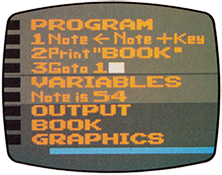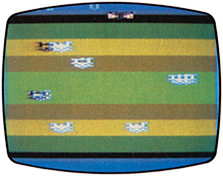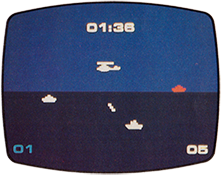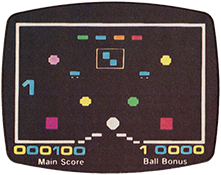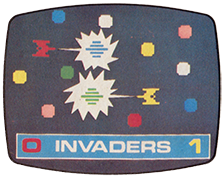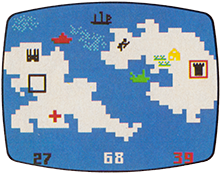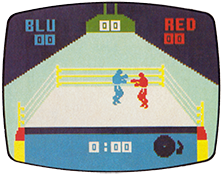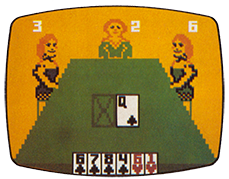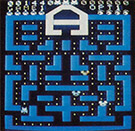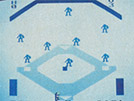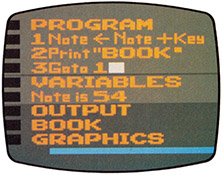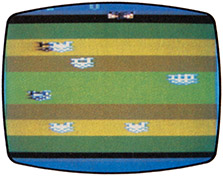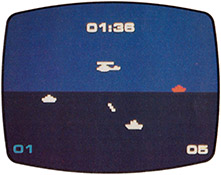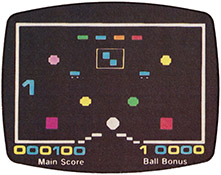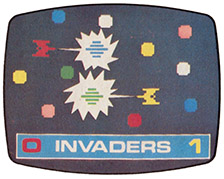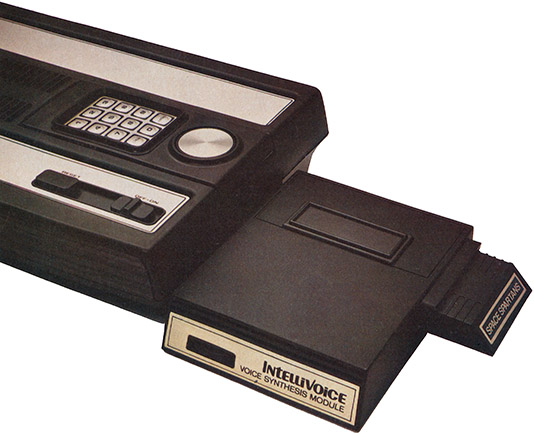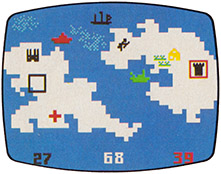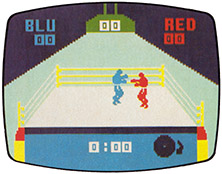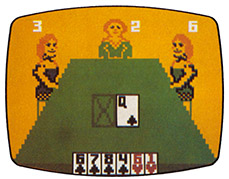
The Players Guide to Programmable Videogame Systems

VCS HARDWARE
The Video Computer System (VCS) has become the subject of an increasing amount of debate among electronic gaming enthusiasts of late. Its staunch defenders champion the VCS as the greatest of all the home fun machines. Detractors snipe back that it’s a technological relic, an outmoded system that ought to be collecting dust in a closet somewhere.
Yet even amid the din of rising voices, one simple truth remains inescapable. There’s no denying it: The Atari VCS is far and away, the most popular home arcade system in the world today. There are more VCS units in use right now than all other brands combined. Software is the same story, thanks to a slew of companies that have jumped at the chance to cater to the huge audience of VCS owners.
Developed in 1978, the VCS—soon to be officially renamed the 2600 by the manufacturer—is a standard programmable videogame system. That means it has low- resolution graphics, a small amount of screen RAM (used to move objects around the display, among other things) and 4K bytes of resident memory. Interestingly, the VCS might’ve had only 4K of memory on board if hardware designers hadn’t convinced the company that it was worthwhile building in the extra capability, even if it wasn’t going to be used immediately.
The VCS is ruggedly constructed to withstand anything short of intentional vandalism. Apart from the cartridge slot, the only major feature on the otherwise plain-looking console is a front panel with an array of four vertically moveable slide switches. Grouped in pairs on each side of the slot, these controls govern (from left to right): on/off, color/black & white, game select and game reset.
Older units actually have six slide switches oh the front panel. The extra set is a pair of left and right difficulty controls, which have been moved to the back panel next to the game ports. While this makes the difficulty levers a little less convenient on the latest machines, it does prevent accidental mis-setting during play sessions.
Each VCS is packaged with a pair of paddles and a set of two joysticks. With a few exceptions, these are sufficient to play most VCS cartridges. Indy 500, a race game, comes with its own special steering controller and several titles utilizing keypad controllers that must be bought separately. (Atari will shortly introduce yet another controller for use with the VCS edition of Star Raiders.) All control devices connect to the back of the console with 9-pin plugs.
The eight-position joystick is an industry standard. The narrow base is small enough to accommodate all but the smallest hands, and the long shaft provides good leverage. The paddles are satisfactory, if not exceptional.
THE VCS SOFTWARE EXPLOSION
Whatever ivory tower technicians may say, it is impossible to view the VCS as anything but very much alive as long as a dozen or so cartridges reach stores each month. Atari offers over 50 cartridges for the system under its own label, and more than 15 independent producers are fielding VCS-compatible cartridge libraries of their own.
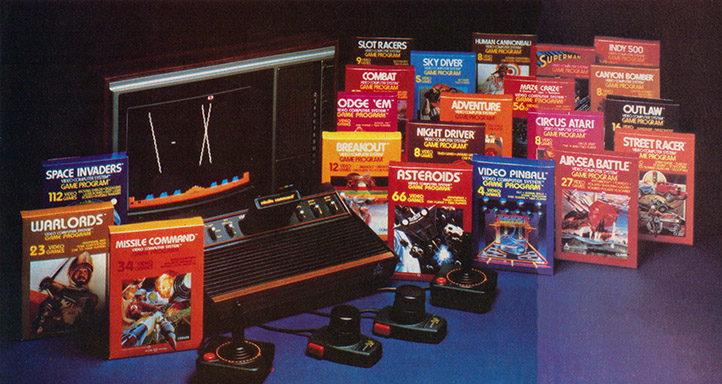
Some of the best games include (manufacturers’ names are in parentheses):
Berzerk (Atari). Clever programming makes this an excellent home version of Stern’s much-loved coin-op maze-shoot. The player must shoot his way through a series of rooms populated by hostile robots.
Defender (Atari). Another hot commercial arcade game that fares well on the VCS is this Williams-designed scrolling shoot-out. The action is virtually non-stop, and the graphics are surprisingly good.
Demon Attack (Imagic). Smooth graphics, multiple menaces and attractive appearance make this one of the very best of all the invasion-type contests. Particularly nice is the fact that some attackers split into two smaller enemies after taking an initial hit from the player’s cannon.
Star Master (Activision). It’s you against a galaxy full of ravening aliens in this space piloting game. This science fiction tour de force boasts both strategic and tactical display screens.
Tennis (Activision). Sports games aren’t really a prime strength for the VCS, but this clever net cartridge is one of a handful of happy exceptions. The best visual bit is that the ball casts a moving shadow in flight, making it easier to follow its trajectory and line up shots.
Donkey Kong (Coleco). This two-screen version of the Nintendo coin-op captures much of the flavor of this climbing game. Help Mario get to the top and release his girlfriend from the dreaded giant gorilla.
Football (Mattel). This M-Network title fills a yawning gap in the VCS line. Skip Atari’s pigskin cartridge in favor of this one.
Space Cavern (Games By Apollo). You’re a space suited figure standing on the floor of a huge cavern on the mysterious planet on which you’ve just landed. You must use your laser rifle to battle flying monsters from above, and shaggy ones that rush at you from the side.
Commando Raid (U.S. Games). You’re in charge of an anti-aircraft gun with the job of keeping the paratroopers, dropped by swarming enemy helicopters, from destroying your installation.
Frogger (Parker Brothers). No VCS-compatible cartridge has better sound than this one, and the action is nothing to sneeze at, either. Steer your frog across the road and river to a safe haven, but beware of those sneaky diving turtles!
SUPERCHARGER: NEW LIFE FOR THE VCS
The biggest complaint against the VCS, even by those who love the system, is its low-resolution graphics. Enter the Arcadia Supercharger, a device that gives this popular machine exactly the shot in the arm it needs.
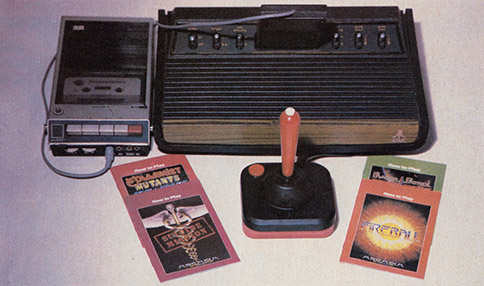
The Supercharger is something new under the VCS sun, a RAM cartridge. It plugs into the regular slot and then attaches to any cassette record via a cable. Games on tape can then be entered into the VCS for playing through the Supercharger cartridge.
What it does, basically, is increase the amount of screen RAM available to the VCS. That means that Supercharger games can have more objects in motion on the screen and render images with more detail than is possible in the ordinary 4K cartridge.
Those with some computer experience may blanch at the thought of connecting their VCS to a tape-based system. Fortunately, the Supercharger enters data so rapidly that loading takes only a few seconds, rather than the 10 minutes or so that is required to load some taped Apple II games.
The Supercharger is list priced at approximately $80 and comes with a Phaser Patrol cassette. Future releases such as Communist Mutants from Outer Space will cost about $15 each.
CUSTOM CONTROLLERS
With the standard Atari 2600 joystick becoming the most commonly-used controller in the videogame universe, it has become the basis for an array of adaptations and additions culminating in a virtual industry. Joystick stands, console type controllers and deluxe joysticks are sprouting like mushrooms.
Currently leading the parade of companies with super controllers is the Chicago’s WICO, already a producer of coin-op controls. Their new joystick is a heavily based controller with both side and top-mounted action buttons. WICO also looks to be the first company to get a tracball controller onto the market. The tracball is fluid and highly responsive and more controllers for alternate systems are on the way.
Discwasher, meanwhile, has a beautifully hand-molded stick with a top-mounted action/fire button and Computability has two joystick models, the Starfighter and the lower-priced Slik Stik, both available for under $20 each.
Fans of button/console controllers can look at either the Starplex or B.C. Controllers, each retailing at $29.95.

A FLEXIBLE HARDWARE SYSTEM
Odyssey is the oldest name in programmable videogame systems for the home, having marketed its first system about a decade ago. Unfortunately, inventors Ralph Baer and Sanders Associates had to use the crude computer technology of that period in creating their machine.
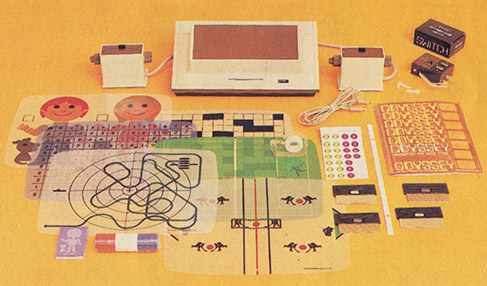
The old Odyssey was something like a dancing dog. It was incredible that it played such a variety of games, even if the games themselves didn’t do much to fire the imagination.
Let’s just say this early experience didn’t go for nothing. It consistently shows up in the company’s current videogame machine, the Odyssey².
This standard programmable videogame’s main advantage is its full membrane-type keyboard. It allows the possibility for a much wider variety of input from the players than is possible with a system exclusively based on joysticks. True, Odyssey didn’t make much use of this feature during the first couple of years the O² was on the market, but the company saw the error of its ways in 1981 and introduced the keyboard-based Master Strategy Series.
Except for the keyboard, the Odyssey² console is simplicity itself. The flat silver-finished unit has a large red on/off button, a cartridge slot and a pair of joysticks wired into the machine. (Handy gamers can detach a defective controller by opening the machine.)
The action button on the joystick mixes good news with bad. They’re large and comfy, but do exhibit a tendency to break down when the gaming action reaches critical mass.
Wiring the controllers into the console does eliminate the problem of plug breakage, but it also creates a serious limitation. The joystick must be used for all cartridges, even those which, like Blockout/Breakdown, would be more fun to play with a paddle.
ARCADE-STYLE SOFTWARE
The Odyssey² is known as the family system because its software library, though not nearly as large as some other systems’ catalogs, is unusually diverse. Whether you prefer shoot-outs or sports, battle games or board games, there’s likely to be something available you’ll enjoy.
Now, the flip side to this particular coin is that there aren’t too many cartridges in any one category. If all you want is sports and then some more sports, you may well want to seek elsewhere. On the other hand, those who have wide-ranging interests may find the Odyssey² most attractive.
Some good bets among O² cartridges include:
UFO (Odyssey). This is not only the best game in the whole Odyssey catalog of software, it’s one of the most compelling action games produced for any home system. You’re the commander of a highly mobile saucer charged with ridding your sector of space from hunter-killer satellites and enemy faster-than-light patrol craft. The cartridge is especially good for those who don’t like long, multi-round games; you’ll be lucky to stay with this one for more than five minutes before your saucer turns into space debris.
Baseball (Odyssey). This is a surprisingly detailed electronic version of the national pastime for two players. Pitching, hitting and fielding all play a part, and the various aspects of the game are woven together quite effectively.
Blockout/Breakdown (Odyssey²). Despite having to be controlled with a joystick instead of a paddle, this is a pretty good wall-bashing (and building) game for one or two players. A nice touch is that the computer is willing to handle either side in solitaire games.
War of Nerves (Odyssey). The unique control system which lets the gamer move an entire army of robots at the same time, is the prime ingredient in creating one of the best video war games ever to be published. Two laser-equipped armies square off against each other and fight on fields with lots of terrain features.
Football (Odyssey). The lack of a scrolling playfield is certain to annoy purists, but this arcade-style pigskin cartridge will surely entertain those who are less than fanatical football buffs. The offense can run and pass, while the defense has the job of rushing the passer and shadowing deep receivers.
Pick Axe Pete (Odyssey). This climbing contest takes you deep into the mines in an exciting hunt for gold. The graphics, though a little sparse, are quite attractive and engaging.
THE MASTER STRATEGY SERIES
Memory limitation has proven to be one of the worst problems facing any designer of videogame software. The folks at Odyssey came up with a novel way of getting around this roadblock: They created a series of games which transfer some of the burden for record-keeping and so forth to the human participants, leaving the O² to take care of the action elements.
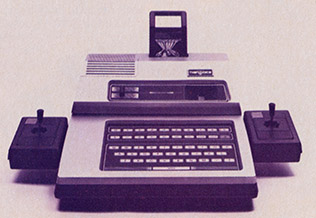
The sumptuously packaged Master Strategy Series of videogame/boardgame hybrids provides gamers with an opportunity to enjoy an unusually rich gaming experience. The individual titles may well be beyond the youngest Odyssey fans, but more mature ones may well find that these contests are their favorites.
Currently available are:
Quest for the Rings. This is a fantasy adventure for two participants acting as a team. Each character has a special power, such as the ability to turn invisible or throw magic spells, to aid him in capturing the 10 magic rings.
Conquest of the World. Global power politics are the subject of this military-tinged simulation. Skillful planning, good timing and an occasional show of force can make your home country into a world-class power.
The Great Wall Street Fortune Hunt. Whether you’re an actual investor or just someone attracted by the glamor and money of the stock exchange, this money game will provide a stern test of your financial instincts. One or more would-be Rockefellers can buy, sell and trade an array of securities.
A prime feature is a display that includes a scrolling stock ticker and newswire.
THE ODYSSEY² SPEAKS
Sometime during the first half of 1983, an extra dimension will soon be added to the Odyssey² videogame system—a speech synthesizer. Usable with a special line of voice cartridges, this device plugs into the console’s slot and, in turn, accepts the usual ROM cart.
Instead of just a few beeps and boops, the O² voice games will feature actual speech. Although a unit was not available for exhaustive testing for this players guide, a special demonstration of the unit’s capabilities was very impressive. The speech is sharp, clear and easily understandable, which should al so greatly enhance play.
The first of the cartridges to utilize the voice synthesizer is K.C.’s Crazy Chase. The game plays without the Voice unit, but obviously, is even better with it.

MATTEL’S MODULAR HARDWARE
Mattel announced the Intellivision, amid a flood of publicity in 1981, as the harbinger of the world of home computers to come. It was projected as a modular system that would begin with the videogame-oriented Master Component and then, through the addition of various modules, be expandable into a full-fledged computer.
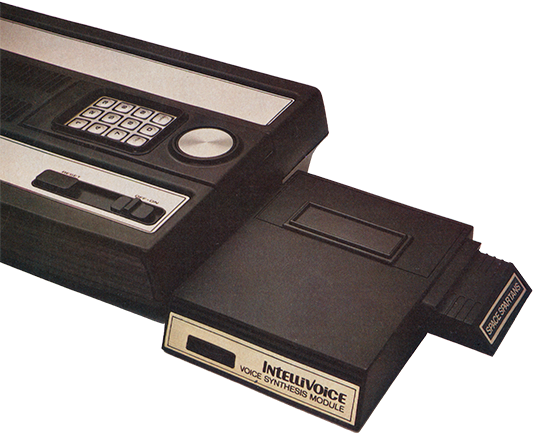
The catalog was bright with promise, but this ambitious plan somehow never got untracked. Only the Master Component has entered into national distribution. The keyboard has been mired in test market for a couple of years, and only an optimist would expect to see it soon.
Does that make the Intellivision a failure? Not to the more than two million videogamers who own Master Components. They’re too busy having fun with the system’s rapidly expanding software collection to worry much about a computer that probably would’ve been something less than state-of-the-art by the time it all came to market, anyway.
The Intellivision as it stands is a senior programmable videogame system. It has high-resolution graphics, roughly 8K of resident memory and significantly more screen RAM (used to move objects around the playfield). In plain English, this means that the images in an Intellivision game look better than those in a standard system cartridge, and more items can be in motion simultaneously than is possible with hardware possessing less screen RAM.
So far, so good. The hitch is that movement speed is somewhat slower in Intellivision games than it is in games that mate with other systems. This is barely noticeable in most of the sports simulations, but it is very much a factor in action-oriented contests.
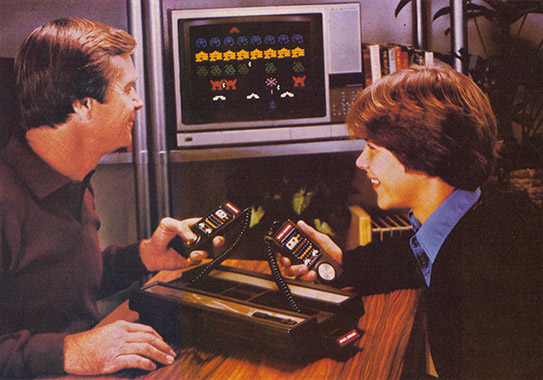
The design of the Intellivision controller magnifies this problem. The command devices, hard-wired into the system on coil cords, each have a monoplanar (flat) keypad, a pair of action buttons mounted on each edge and the controversial direction disc. Though the disc certainly has its supporters, many arcaders find it frustrating to use the disc to steer in games which require rapid changes in direction.
One feature of the Master Component that may come in handy is that cartridges are plugged in on the right side rather than loading from the top. Since the controllers fit into niches that allow them to lie flush with the top of the console, the Intellivision can be stored on a much skinnier shelf than some of the other machines—and it doesn’t need appreciably more “head room” when it’s actually in operation.
SUPERB SPORTS SIMULATIONS
With the exception of professional wrestling, just about every team or individual sport worth mentioning has found its way into the Intellivision cartridge lineup. No videogaming system—or home computer, for that matter—at any price offers sports cartridges in such quality and quantity.
Some (of the many) superior cartridges include:
Major League Baseball. Two managers can match wits in the most comprehensive baseball action game ever created. Pitching and batting are satisfyingly detailed, and no electronic version of the national pastime has a more fully realized fielding component. Keypad input allows for individual control of every fielder on all plays.
NFL Football. The only possible rap against this one is that it is such a realistic simulation of gridiron thrills that it may be too complex for those who aren’t fairly knowledgeable about the real-life sport. The selection of available formations and plays is awesome.
USAC Auto Racing. This is a rarity among the sports games in that it can be played solitaire as well as head-to-head. Multiple courses of varying difficulty as well as a choice of cars makes it easy to pick a variation that’s appropriate to the player’s skill level.
NASL Soccer. Although there are only three men from each team on the screen at a time, the scrolling playfield permits realistic play-making and passing since you can boot the ball to off-screen teammates.
NBA Basketball. This is easily the best hoop cartridge available today. Clever use of the overlays makes it simple to work the ball around the court and set up a high-percentage shot.
NON-SPORTS SOFTWARE
It would be a gross oversimplification to say that the only good Intellivision cartridges are the sports games. While the systems’ software designers haven’t fared quite as well with action games, there are a few well worth considering. A recent development which has improved the situation is that cartridges from independent publishers are now reaching stores for the first time, expanding the selection of titles.
Some of the most exciting titles (manufacturers’ names in parentheses) are:
Space Battle (Mattel). This interstellar combat game combines tactics and strategy by offering two distinct playfields. In this solitaire game, the commander dispatches three squadrons to deal with enemy fleets streaking toward his mother ship. When the rival forces meet in space, switching to the battle display allows the player to take command of a space fighter and deal with the menace personally.
Night Stalker (Mattel). This is an intriguing maze-shootout that is only slightly marred by an inappropriate control scheme. You must use all your wits to avoid the increasingly deadly robot attackers.
Demon Attack (Imagic). In many ways this can be considered a deluxe edition of the game that won the hearts of VCS players across the country. Slick graphics highlight this fast-moving invasion-style game.
Armor Battle (Mattel). Forget all previous tank combat games, this is the one. Each team has two armored vehicles and can switch back and forth between them at will. The terrain, seen in overhead perspective, is both varied and detailed.
WORDS TO PLAY BY
Voice modules are turning up all over, but Intellivision has the distinct advantage of being the first out of the gate. Their Intellivoice module plugs directly into the cartridge slot of the Master Component and special, non-compatible voice videogames are, in turn, slipped into the voice module.
The earliest releases for this new line include Space Spartans, a jazzed-up, revamped version of the early classic Space Battle, complete with words to live by from command center—male and female voices alternating, but randomly—giving constant updates on bases and on-board equipment, and B-17 Bomber.
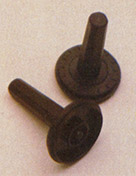
COPING WITH INTELLIVISION CONTROLLERS
While hailed as a great innovation at the time of their introduction, the Intellivision hybrid keypad/disc controller has proven something of a lemon in gaming circles. Especially when engaged in fast action, arcade-type contests, the disc proves both clumsy and painful to manipulate.
In answer to the growing need for a joystick-type adaptor, several bright-eyed inventor’s have developed ways around the problem. Video Product Sales, for example, has the lnjoy-A-Stick, essentially a replacement disc for the controller with a joystick-like shaft attached. Fans of knob-type joysticks, however, might prefer the Skil-Stik from C & T Creations of Providence, RI.

THE STRANGE HISTORY OF ASTROCADE
Before there was a VCS or an Odyssey², the Bally Manufacturing Company introduced a machine under the name, Bally Professional Arcade. The company billed it as a videogame machine with computer-like features that could be upgraded to a full-scale microcomputer through the addition of planned modules such as a keyboard.
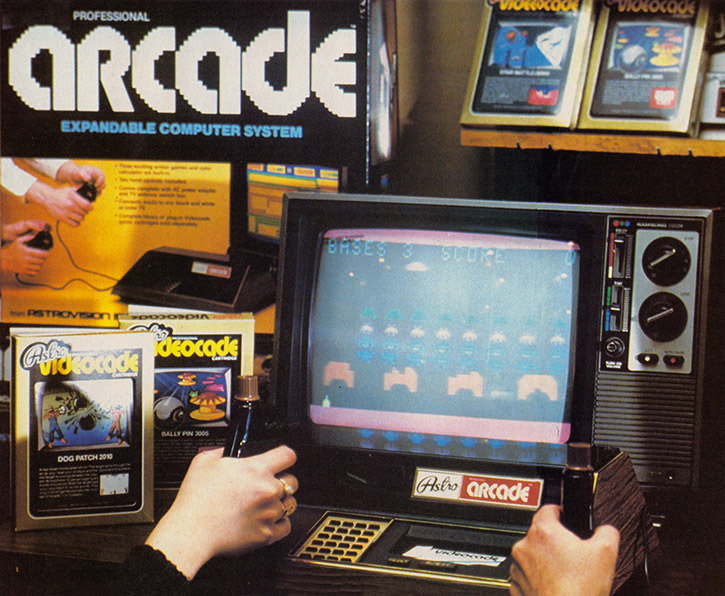
This was a fine-sounding plan that never came off. A combination of problems, including a stiff retail price and Baily’s lack of experience in marketing consumer products, caused the company to pull in its horns in favor of concentrating on the coin-op business it knows so well.
Yet the system refused to die. User groups filled the void by producing both hardware and software for the machine. It was fairly simple to use the Bally BASIC cartridge to program videogames for the machine, and this resulted in something over 200 games on cassette tape for the system. A couple of suppliers have even brought out keyboards!
The system continued its underground existence until 1981, when a new company called Astrovision acquired the exclusive license to make and market the machine and its software. One quick name change later, and Astrocade, Inc., had the revived Astrocade back in the stores. The company is creating new games, has produced a revised version of the BASIC cartridge and is even getting a ZGrass keyboard ready for introduction in the near future.
THE HARDWARE SYSTEM
The main features of the unit’s front panel are a cartridge slot, reject button and a calculator-style keypad. The 24 keys can be used to produce full alpha-numerics for home programming, though it’s quite arduous to input programs using this keypad.
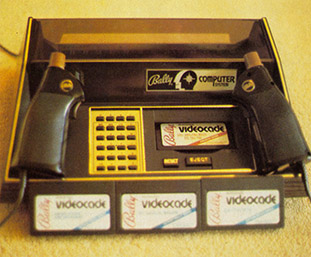
Many consider the Astrocade controllers to be the best available as standard issue. The gun-grip command device has a paddle, joystick and a trigger, permitting some complicated player-game interaction. The ability to combine the rotational movement of the paddle with the directional movement of the joystick turns games that would be glorified Pangs on other systems into genuine electronic simulations found here.
A real plus is that the controllers can be used to select the game, number of players and other variables without need to approach the console. This comes in especially handy if you do your gaming on a giant-screen television set. Too bad there’s no remote reset key or any way to insert a cartridge from across a room. Still being able to handle most of the preliminaries using the controller is a real convenience.
The Astrocade is also unique among current systems in that it provides the bonus of three resident games and a built-in calculator. Gunfight is a nifty wild west showdown, Checkmate is a line-building contest for up to four players, and Scribing is one of the best video drawing programs found this side of the high-end microcomputers.
ACCESSORIES ADD DIMENSION
As mentioned, those who would like to upgrade their videogame to the status of an actual personal computer down the road, could do worse than investigate the Astrocade. It is the best bet for such conversion among the four established systems.
Not only is the ZGrass keyboard likely to open computer graphics vistas for would-be programmers, but the Astro BASIC cartridge gives owners a chance to see how they do as amateur game inventors.
ASTROCADE SOFTWARE
Despite its relatively long life in the market, the Astrocade still suffers from a scarcity of games on ROM cartridges. The best Astrocade programs—Clowns, Red Baron, Football, Galactic Invasion, Space Fortress, and The Incredible Wizard—are strictly first class. Some of the rest of the titles in the catalog—Dogpatch comes to mind immediately—look like a misguided attempt to beef-up the number of titles in the software catalog at the expense of quality.
The user-produced games do improve the situation somewhat. The catch is that they’re only available through the mail at this writing. Astrocade has shown some interest in working more closely with its legion of fans, so they may change in 1983. (Meanwhile, check the January issue of Electronic Games for a fuller description of games on cassette.)
Some of the best Astrocade ROM cartridge games are:
The Incredible Wizard. Designed by the same man, Bob Ogdon, who worked on the Midway Wizard of Wor coin-op, this home version may actually be a slight improvement over the original. One or two players try to keep the mazes free of monsters, some of whom turn invisible and must be tracked on the small radar screen located at the bottom of the display.
Space Fortress. The arcader controls the armament of a large space station located smack in the center of the playfield. Aliens approach from the four cardinal directions, firing as they come. The captain of the station must destroy everything in sight before the fortress suffers a deadly collision and blows up with a screen-filling explosion.
Galactic Invasion. This home version of Midway’s Galaxian coin-op features nine different levels of skill, and the action can become pretty intense at upper difficulty settings. Your job: wipe out the swooping aliens before they blast your ship to atoms.
Clowns/Brickyard. Talk about “best buys”! This cartridge includes a pair of programs that could easily have been sold separately. One’s a wall-bashing contest, while the other involves bouncing a pair of clowns on a teeter-totter so that they sail up to the top portion of the playfield and break the balloons floating there.
Football. This sports simulation offers enough scope to satisfy serious football thinkers, but the control scheme is so beautifully constructed that it is pretty simple to learn even for those who don’t live and die by what happens on the nation’s gridirons.
Red Baron. Fight in the skies with this air-war game. Nice rendering of the planes makes it a pleasure to look at as well as to play.
Several new games will be made available soon.

A HIGH-POWERED SYSTEM
Experienced consumers know that it’s rare for a product to actually live up to its advance press clippings. After all, claims are a dime a dozen as long as no one is in a position to test their truthfulness.
So if electronic gamers took a skeptical attitude about ColecoVision during much of 1982, it was only common sense. Now that this third wave system has reached the consuming public, the prevailing verdict is that ColecoVision may well be even better than promised.
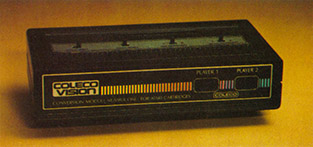
The system’s console features the bare minimum of controls, since game selection and re-start are handled with the controllers. There’s an on/off slide switch and a re-set button on the top panel, an interface on the front which will accept forthcoming ColecoVision modules and two niches for the controllers on the top toward the left-rear.
The controllers feature a doorknob joystick, a mono-planer keypad and a pair of action buttons. The command device is perhaps just a little large for the small-handed to grip comfortably, but should present no serious problem. The joystick is only fair-to-middling, however, and home arcade aces will no doubt look forward to being able to buy some sort of gourmet joystick to enhance play.
SOFTWARE BRINGS COIN-OPS HOME
The capabilities of the ColecoVision, particularly its 6K-plus bytes of screen-RAM, result in games that look and play better than anything seen on a home system so far. The colors are deep and rich, the images are intricately detailed, and the play-action is most satisfying.
Coleco itself plans to specialize primarily in home editions of games that should be familiar to those who frequent the family fun centers, along with a few adventure and sports titles. It’ll be up to third-party software publishers to produce original contests in order to fill out the ColecoVision-compatible catalog. If early sales momentum for the system holds up, it won’t be long before other companies hop on the bandwagon, either.
Meanwhile, ColecoVision owners can revel in such electronic treats as:
Donkey Kong. Your girlfriend is the prisoner of a giant ape who has spirited her to the top of a half-completed skyscraper. It’s up to you as Mario the heroic maintenance man to scale the ladders and complete the rescue. Three screens of action provide lots of variety.
Cosmic Avenger. This futuristic scrolling shootout puts the gamer in command of an air/sea craft armed with both lasers and bombs. Battle city defenses, UFOs, tanks, submarines and undersea guns can be found in this fast-paced war game.
Smurfs. This adventure game features graphics which can only be compared with Saturday morning cartoon shows. The object is to leap over the obstacles on the road to Gargamel’s castle, where the Smurf hero must save the Smurf-ette.
Venture. This home edition may, at last, bring this game the acclaim it has deserved since Exidy introduced it in the commercial arcades. Explore the various rooms, outwit the monsters and snag the prizes. Sound and graphics are straight from the original quarter-copper.
THE EMULATORS ARE COMING
Lack of compatibility between various videogame machines has proven a bone in the throat of the electronic gaming hobby. Both Atari and Coleco, however, are taking some steps designed to ease the situation.
Emulators that attach to the ColecoVision and Atari 5200 will soon make it possible for owners of the systems to play cartridges originally designed for the VCS. It won’t improve the games any, of course, but this will make it possible for all owners of the Video Computer System to upgrade their home arcade equipment without sacrificing the investment they’ve already made in cartridges for their present machine. As with all hobbyists, there is a natural inclination to want to “trade up”—buy a superior system that will remain compatible with their current videogames.

INSIDE THE CONSOLE
Beneath the sleek exterior of the Atari 5200 lurks the throbbing power of a 64K computer designed specifically to play high-quality games. This third wave programmable gaming system has the screen-RAM needed to get the job done, too, and the initial group of cartridge releases looks at least as good as the carts for the company’s 400 and 800 computer systems with some improvement.
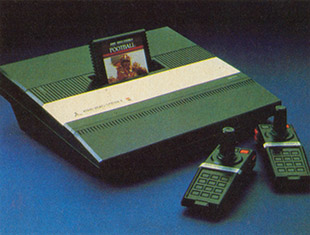
Game functions such as pause and reset are handled with the controllers, so the console sports a clean and uncluttered look that is most attractive. It physically resembles the housing originally scheduled for use on the remote control VCS, though the overall effect is even better.
The controllers for the new system are a gallant attempt at crossbreeding the trakball and conventional joystick. The harder the stick is pushed in any given direction, the faster the on-screen moving object zips across the playfield. Atari must be congratulated for its attempt, but the examples tested by EG demonstrate that there are still some bugs needing to be ironed out. (Atari intends to have a true Trakball controller available soon.)
ATARI 5200 SOFTWARE
How exciting the 5200 software list looks will largely depend on the viewer’s vantage point. Those who already own an Atari 400 or 800 computer—or possibly even a VCS—will not be quite as enthusiastic about the selection as someone who has owned either a different brand of fun machine or is about to make a first videogame purchase.
Like any new system, there isn’t a lot of variety yet. Most of the cartridges are tried-and-true Atari Classics like Missile Command and Space Invaders, altered slightly from their computer versions. The line also includes football and baseball games as well as Atari’s official home edition of Galaxian.

Access to the family television set has always been essential to gamers. Even the best videogame system was useless without an output device such as is provided by a TV picture tube.
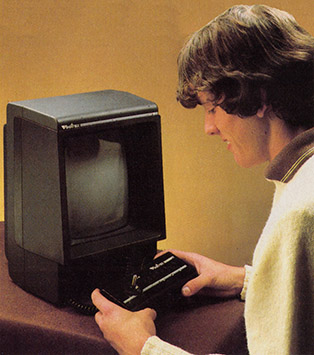
At least, that was the situation until the introduction of Vectrex, a self-contained system built around a 9-in diagonal vector graphics monitor. This technology, employed to stunning effect on Atari’s Asteroids coin-op, produces luminous, crisp line-work with a lot of three dimensionality.
The Vectrex s monitor is black and white, but this isn’t quite as big a drawback as you’d think. Easing things a bit is the clever use of color overlays. With some cartridges, such as Scramble or Rip-Off, you can almost forget everything is black and white in the heat of action.
The cartridge line is still very small, but it’s all good-quality stuff. Scramble, in particular, is one of the classiest scrolling shoot-outs produced for any videogame system this year.
Other notable cartridges include Hyperchase, a multi-scenario racing game, and Star Trek, a deep-space shoot-out. The Vectrex comes with one game, Mindstorm, resident, and it’s so good that it probably would have sold well as a separate cartridge.
Arcadia 2001: Portable & Powerful
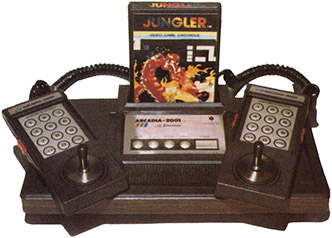
This senior programmable videogame system has just become available as this issue of Electronic Games goes to press. Although it’s not for everyone, this Emerson fun machine appears to have a definite role to play in the hobby.
Since it operates on direct as well as alternating current, the Arcadia 2001 makes a perfect portable. Its small size won’t take up much baggage space, so it can come along on vacations and trips.
Another amazing thing about the Arcadia 2001 is the price. It’s selling for $99 in discount outlets, the lowest-ever price for a senior system.
In truth, the Arcadia 2001 does have some drawbacks. The controllers aren’t very responsive and the game graphics, though good as far as they go, are a little sparse. There’s a library of a couple of dozen cartridges to keep gamers entertained.
WHAT’S NEXT FOR VIDEOGAMES?
The future of home programmable videogame sys tems holds-you guessed it!—more new systems.
Making its debut next month will be Ultravision. This premium-priced unit is a stand-alone programmable with 64K of resident memory, high fidelity sound (including a headphone option), professional-quality 16 position joystick and its own high resolution color monitor.
On its way from Commodore is Max, slotted as the junior member of the company’s line of machines which includes the VIC-20, VIC-64 and PET. Not much. is known about the capabilities of the Max, but it is expected to be a senior programmable videogame system that will also provide a sampling of the joys of personal computers.
There are undoubtedly other systems waiting in the wings even beyond these. Despite the popularity of videogames, only 15% or so of all American families have them, leaving plenty of room for new entries into the field to grab a sizable audience.
Source Pages













